This tutorial will guide you on how to perform a minimal installation of latest version of CentOS 7.0, using the binary DVD ISO image, an installation that is best suitable for developing a future customizable server platform, with no Graphical User Interface, where you can install only the software that you need.
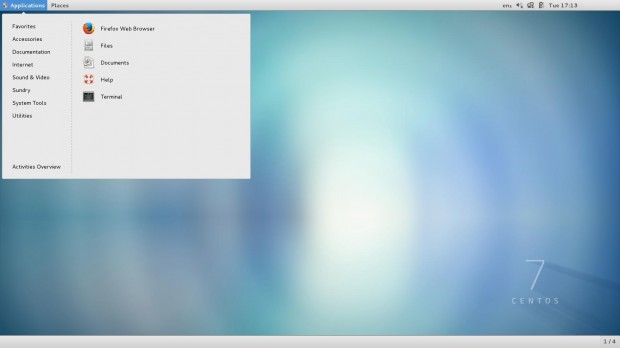
If you want to find out more about what’s new in this release of CentOS 7.0 holds and download links, I suggest reading the previous article on release announcements:
Requirements
- CentOS 7.0 DVD ISO
CentOS 7.0 Installation Process
1. After downloading the last version of CentOS using above links or using official CentOS download page. Burn it to a DVD or create a bootable USB stick using LiveUSB Creator called Unetbootin.
2. After you have created the installer bootable media, place your DVD/USB into your system appropriate drive, start the computer, select your bootable unit and the first CentOS 7 prompt should appear. At the prompt choose Install CentOS 7 and press [Enter] key.

3. The system will start loading media installer and a Welcome screen should appear. Select your Installation Process Language, that will assist you through the entire installation procedure and click on Continue.

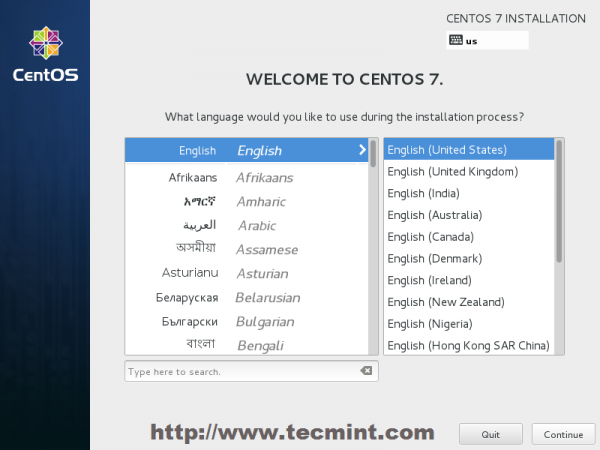
4. The next step, present screen prompt is Installation Summary. It contains a lot of options to fully customize your system. First thing you may want to setup is your time settings. Click on Date & Time and select your server physical location from the provided map and hit on upper Done button to apply configuration.

5. The next step is to choose your Language Support and Keyboard settings. Choose your main and extra language for your system and when you’re finished hit on Done button.


6. The same way choose your Keyboard Layout by hitting the plus button and test your keyboard configuration using the right input filed. After you finish setting up your keyboard, again hit on upper Done button to apply changes and go back to main screen on Installation Summary.


7. On the next step you can customize your installation by using other Installation Sources than your local DVD/USB media, such as a network locations using HTTP, HTTPS, FTP or NFS protocols and even add some additional repositories, but use this methods only if you know what you’re doing. So leave the default Auto-detected installation media and hit on Done to continue.


8. On the next step you can choose your system installation software. On this step CentOS offers a lot of Server and Desktop platform environments that you choose from, but, if you want a high degree of customization, especially if you are going to use CentOS 7 to run as a server platform, then I suggest you select Minimal Install with Compatibility Libraries as Add-ons, which will install a minimal basic system software and later you can add other packages as your needs require using yum groupinstall command.
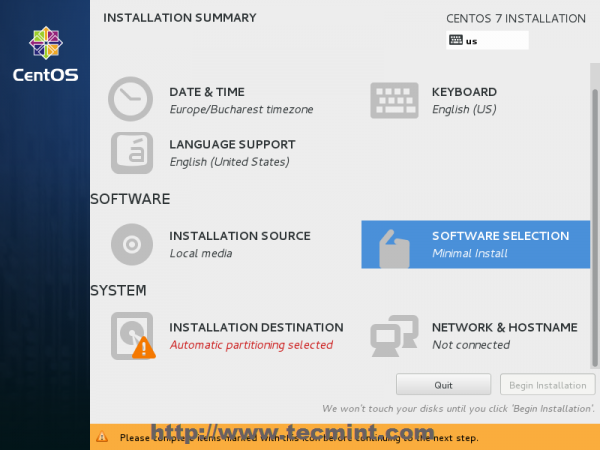
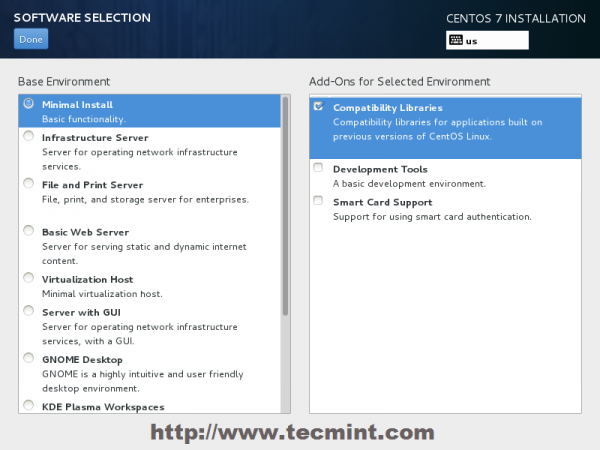
9. Now it’s time to partition your hard-drive. Click on Installation Destination menu, select your disk and choose I will configure partitioning.
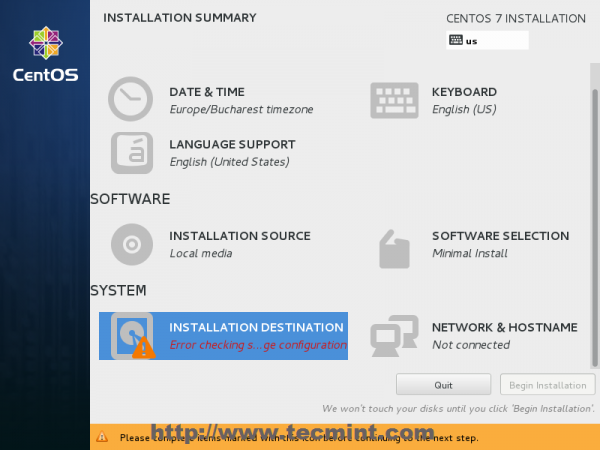

10. On the next screen, choose LVM (Logical Volume Manager) as partition layout and, then, click on Click here to create them automatically, option which will create three system partition using XFS filesystem, automatically redistributing your hard-disk space and gathering all LVS into one big Volume Group named centos.
- /boot – Non LVM
- /(root) – LVM
- Swap – LVM

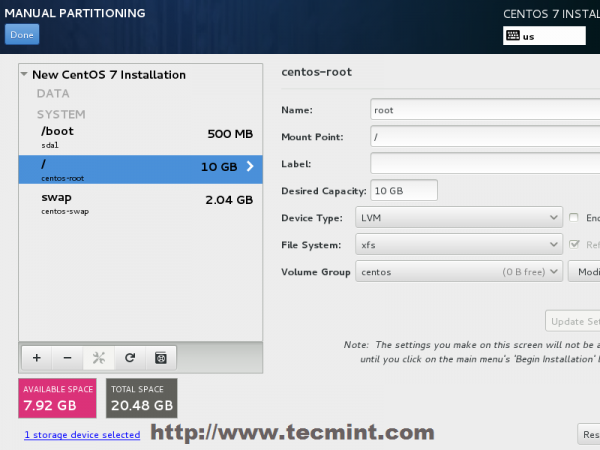
11. If you are not pleased with the default partition layout done automatically by the installer you can completely add, modify or resize your partition scheme and when you finish hit on Done button and Accept Changes on the Summary of Changes prompt.
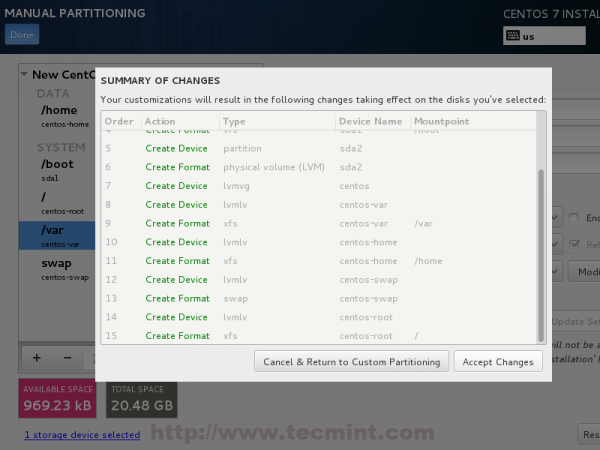
NOTE: For those users, who have hard-disks more than 2TB in size, the installer automatically will convert partition table to GPT, but if you wish to use GPT table on smaller disks than 2TB, then you should use the argument inst.gpt to the installer boot command line in order to change the default behaviour.
12. The next step is to set your system hostname and enable networking. Click on Network & Hostname label and type your system FQDN (Fully Qualified Domain Name) on Hostname filed, then enable your Network interface, switching the top Ethernet button to ON.
If you have a functional DHCP server on you network then it will automatically configure all your network setting for enabled NIC, which should appear under your active interface.
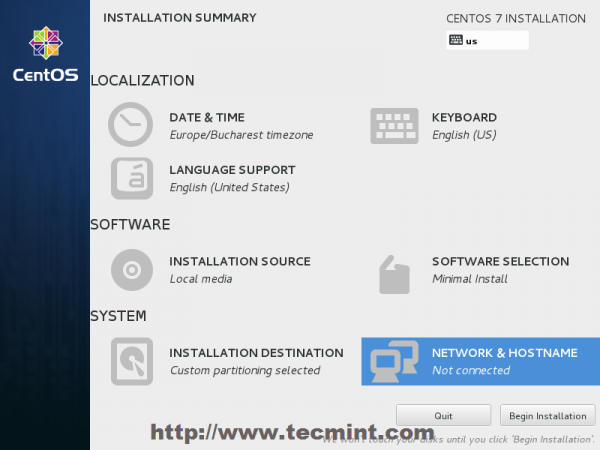

13. If your system will be destined as a server it’s better to set static network configuration on Ethernet NIC by clicking on Configure button and add all your static interface settings like in the screenshot below, and when you’re finished hit on Save button, disable and enable Ethernet card by switching the button to OFF and ON, and, then hit on Done to apply setting and go back to main menu.

14. Now it’s time to start installation process by pressing on Begin Installation button and set up a strong password for root account.
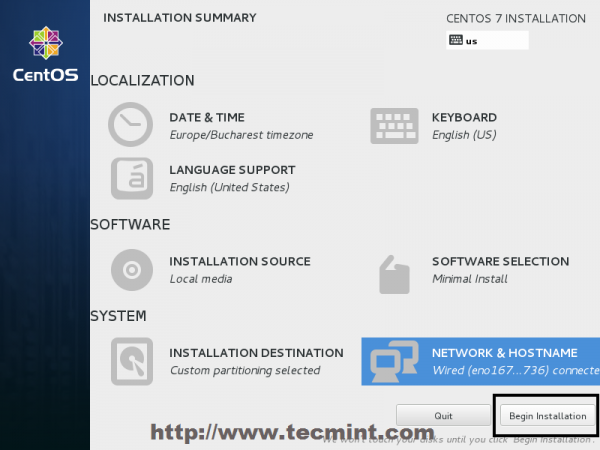
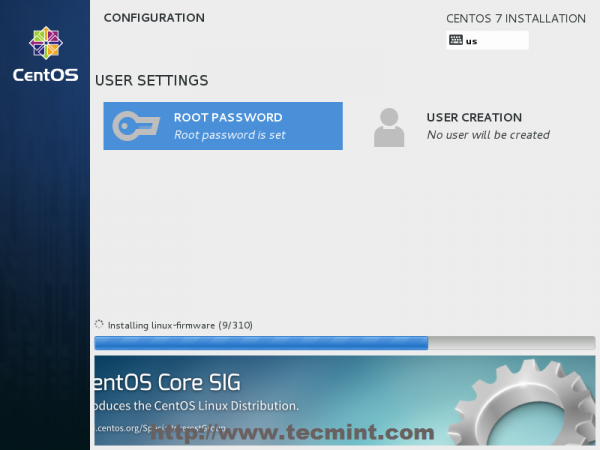

15. After you finish setting up a strong password for root account move to User Creation and create your first system user. You can designate this user to become a System Admin with root privileges using sudo command by checking the box Make this user administrator, then click on Done to go back on main menu and wait for the installation process to finish.
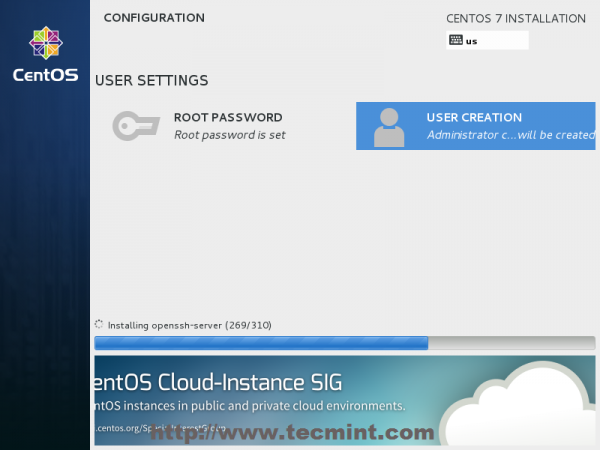

16. After the installation process finishes, the installer will show a successfully message on screen, demanding to reboot your system in order to use it.

Congratulation! You have now installed last version of CentOS on your bare new machine. Remove any installation media and reboot your computer so you can login to your new minimal CentOS 7 environment and perform other system tasks, such as update you system and install other useful software needed to run day to day tasks.




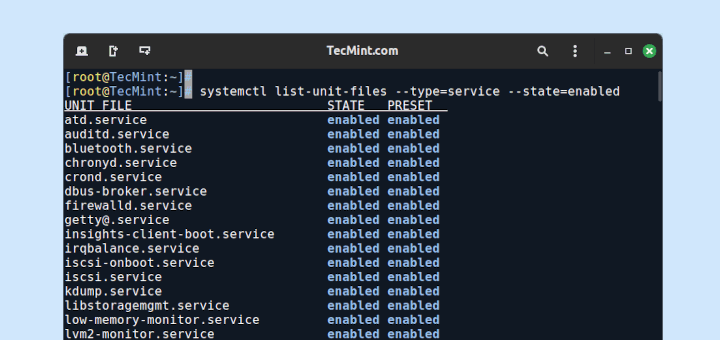


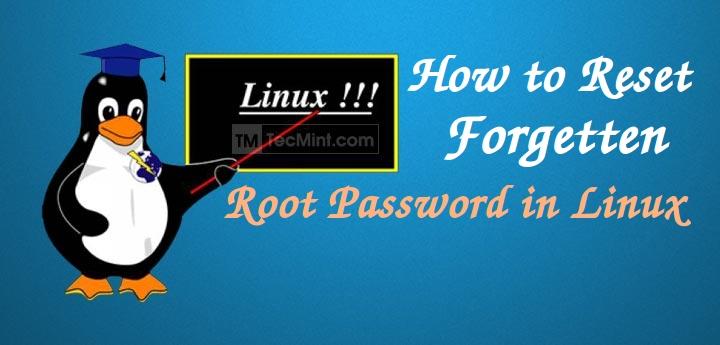
I just see the message “press the enter key to begin the installation process“. I press Enter and nothing happens.
I have downloaded Centos 7 from
https://mirror.yandex.ru/centos/7.9.2009/isos/x86_64/.@Dmitry,
CentOS 7 is old, why not go for Rocky or AlmaLiux 9?
Can i go through above partitions size for creating my own VM for learning linux.
Please help to suggest.
@Prafulla,
Better create only one partition
/with 30GB or 40GB.Ok, I will do it and if any issue then I will let you know.
Thank you I followed the all above steps and successfully able to install Centos 7 in my older laptop.
I created a Centos VM:
I would now like to create an FTP server. I am unable to download the iso since there is not enough space in
/home. Do I increase the/homeor is it possible to download to the /dev/mapper/centos-home?@Tar,
Either free up some space on /home or download ISO in /dev/mapper/centos-root.
Thanks, but I want to install it on my PC to try it. I have 2 partitions NTFS I don’t want to delete it.
Thank you sir, this tutorial really helped me. First I tried to use unetbootin but failed, then I used RUFUS and it worked. I asked permission to rewrite this tutorial to my blog.
@Ores,
That’s great, yes Unetbootin sometimes failed, RUFUS always works. Sorry you can’t re-publish this article on your blog.
Install CentOS from UEFI, not Legacy, because Windows is surely installed via UEFI. In Windows cmd with admin privileges run: bcdedit
Identify CentOS efi partition and run:
bcdedit /set '{bootmgr}' path \EFI\refind\refind_x64.efiAdjust path with bcdedit output result.
After booting to the usb i get this:
Im not using server grade tech.
I built a custom pc into a 4u server with the following specs:
Any idea what my issue is? I have tried installing so many times. I have turned on Legacy and turned off secure boot.
ive tried a different USB and even a different cpu and mobo. ive installed centos 7 on a usb at least 10 times. ive tried minimal, dvd, and everything. NOTHING works. but i can load windows 10 on it no issue haha. Ideas?
The CentOS bootable USB must be created using a UEFI supported utility: Rufus in this case does the job
I tried the above steps on a bare machine (new and without any OS), but forgot to manually partition my disk (step 10). I wanted to repeat the installation procedure from scratch and boot from my bootable USB again in order to do my own partitioning. However, when I reboot the system and I choose the booting option in BIOS to be from my USB, the system freezes and never proceeds further to save and exit! I have repeated this a few times and the same problem occurs. Any idea why this happens!?
I don’t get the expected screen when trying to install CENTOS 7 on a desktop. I created the bootable DVD, changed the boot sequence, installed the DVD, and the bios asked if I wanted to “Install CENTOS 7”, all of which I expected.
After that I just get:
After that… the machine does nothing further. Please help!
Give more details about machine resources, CPU, RAM, bios/efi , installation type (boos/legacy/efi/csm)
What is the command to get GUI after the successful local host login?
After I logged into the local host there appears something like this
Need help urgently..
https://unix.stackexchange.com/questions/181503/how-to-install-desktop-environments-on-centos-7
Thanks a lot admin, I have installed successfully, it’s a very helpful content for newbie
I want to setup and configure Zimbra Collaboration Suite in CentOS 7 but I’m confused what CentOS image I will choose if it’s DVD iso, Everything iso or Minimal iso. Please give me the right iso I will download. Thank you.
@Ken,
Go with CentOS 7 Minimal ISO images, which is enough to install Zimbra Collaboration Suite in CentOS 7.
@Ravi thank you for the reply :)
@ravi Sir, its recommended to chose minimal or basic web server? i want to build a webserver (LAMP)for my website
@Clark,
Choose minimal with basic Web Server installation for CentOS..
I want to install Linux in my usb (pendrive), i want to use it live please suggest me how can i use that?
@Shubham,
Its simple, during installation drive selection, give your USB drive location..
Use unbootin to create a bootable USB drive with a live ISO Linux distro (CentOS is not a live linux distro) or Rufus to create bootable live USB for UEFI compatible machines. Instaling directly to a portable USB instead of a fixed Hard Drive will mess things out (MBR stage one bootloader/ GPT) and can render your machine unable to boot.
Hi Cezar,
I will give it a go on a windows 7 a machine. One question though will it create a dual-boot system after following all your steps?
I have prepared a USB with UNITBOOTIN!
Will update you on status! :)
How do I remove window 7 and install centos?
Delete all partitions from HDD, repartition and install CentOS.
Are you trying to perform the installation directly on laptop or in a virtual machine inside the laptop? Does it throws you any errors whatsoever? what’s you machine resources in terms of RAM, CPU and HDD?
Thanks again. Which filesystem is recommended for each partition? The default is XFS but I think EXT 4 is much safer.
@Armin,
Yes, go with ext4 filesystem for better safer, faster and stable..
What is the recommended partition scheme for a 250GB hard disk to install Plesk? the partitioning section in your tutorial is very short. I don’t know which is the best practice to configure my VPS with 4GB of Ram and 250GB of hard disk space.
Thank you.
@Armin,
This CentOS 7 installation is just an example to setup, you can use any size no matter whatever it be and create x number of partitions.. You can get the recommended size for Plesk from its official site..
Thanks for the tutorial. Is this configuration proper for installing Plesk to create a web hosting server?
@Armin,
Yes, but Plesk should be installed on newly fresh minimal CentOS 7 installation, I think you should go ahead and install Plesk on same..
Hi,
Very nice tutorial but, I have a problem.
At the time of partition it shows only 8312 kb left , whereas I have more than 100 GB free.
Please help me
@Paath,
Thanks for finding this article very useful, could you share the screenshot of your partition table? so that we can help you out..
under the Network & Hostname i didn’t find any connected card..
even then i manually input data into ipv4 settings.
while installation i didn’t find any error but unfortunately after reboot i get only blank screen.
kindly help me.
Thanks
Nadeem
I had the same problem.
The solution is to put the Swap partition outside of LVM
Boot and Swap non LVM
The instillation source displays an error when I try to install from USB, everything else seems to work fine. I used the Fedora USB creator with the DVD1 ISO. Any help greatly appreciated.
What kind of error it displays you? Is your machine UEFI based? In any case use Rufus to create a bootable USB stick UEFI compatible or if you want to do Legay Mode use Universal USB Installer tool from pendrivelinux.com website.
@sgr1 @harsh: Centos 7 requires minimum 1Gb RAM to run! The installation runs smoothly with aprox 2GB of RAM!
Hi
Thanks for studying, Complete and usable
regards
My installation keeps crashing after I complete all the setup and hit begin installation. It says “An unknown error has occured” send bug report or quit. I have tried several different CentOS 7 disks and get the same error. Also checked the disk for errors.
Any suggestions? Can you learn anything from the error report?
Using the Centos 7 x86_64-Minimal_1503-01 disk.
Gigabyte GA-965GM-S2 (Intel G965 Chipset)
Intel Core 2 Duo E6300 1.86GHz / 2MB Cache
2GB RAM
2X 160GB SATA HD RAID 1
Try a different Linux distribution and see if the problem persists? Maybe there’s a hardware problem with your machine!
Is there a hardware requirements list for CentOS 7?
I have a problem like you
of course i want to install CentOs 7 1511 DVD (.iso) on vm ware
can anybody help me ?
Go to vmware machine settings and perform the installation based on centOS dvd iso.
Hi, very nice tutorial, but I’ve got a problem. My CentOS 7 installation stucks after I hit “Install CenOS 7”. It doesn’t move out of stuck boot window. Please help me regarding this. Thank you !!
Same here, tried with minimaliste and complete versions, both x64 on a laptop
hi! do you have centos 7 for beginners tutorial step by step up to advance thanks!
@Art,
Here is the complete guide to learn Linux from newbie to advance..
https://www.tecmint.com/free-online-linux-learning-guide-for-beginners/
I ve recently installed centos 7 everything went fine I have a doubt how can I access from my other system using browser to this newly configured centos 7 server ip address help me I have more doubt on this category awaiting your reply
@Arvind,
You mean to say that you want to access the IP address of CentOS 7 server? then you should install Apache, here is the guide to setup Apache on CentOS 7.
https://www.tecmint.com/install-lamp-in-centos-7/
Dear sir
Excellent one .Help me lot
Very good document, I justed finish installation the centOS 7 by following your doc. Thank you very much!
I have installed 64 bit CentOS 7 1503 in pentium i-3 system. CentOS -7 is installed. It is boot for centos 7 and its rescue mode only. In a separate partition there is also Winows 8 (64 bit) in my system. But multi operating system grub is not obtained. More over
‘grub-install’ command does not take CentOS 7 (64 bit). How the dual boot system canbe obtained (like windows 8 (64 bit) and CentOS 7).
Has there any solution? Please inform me the technique for dual boot loader for 64 bit Windows 8 and CentOS 7.
More over what is command (like ‘grub-install’ in CentOS 6) to install boot loader from rescue mode.
ASOK MALLICK
31/05/2015
I have noticed that you are using vmware, I have installed centos7 with vmware for many times. However, I just can not access the internet after installation.I am using win8.1 and vmware9.0. I have tried to shutdown firewall, using nat or host-only and bridge method,dhcp or static ip via editing ifcfg-ethxx file. No matter what I tried, it just didn’t work.can you help me?thx,sincerely
It seems to be a problem with your host system win 8 or VMware. As long as you have internet connection on the host system, vmware should have internet also. check win net interfaces!
hi Matei,
though I haven’t started it yet on the actual hands-on installation but I find your steps on centos very interesting …
any way, in my entire computer life that I am used of Windows from as far as I can remember starting with Win 95 ..
as of the moment, I want to venture into learning centos installation. however, I’m a little bit worried that lack of Linux-based experienced will be an obstacle.
hoping then you can be my mentor specially on the aspects starting from downloading centos installer then to installing it in a new pc, as well, install some of the basic free online programs.
hoping to hear from you soon using the email address I used on this comment.
thanks,
~aRt
How do you turn CENTOS7 online? Seriously, there’s nothing in the FAQ and nothing in the help. Why would it install “offline” out of the box? It is such a stupid waste of time.
You comment has no meaning to to? What you are referring to?
When you installed the system and partitioned the hard-drive, did you realocate the space correctly and leaved the windows NTFS partitions untouched? Also…windows 7 appears on you GRUB menu?Boot into CentOS 7 and verify the /boot/grub2/grub.cfg menuentries for a Windows record. Also…manually mount the windows partitions and try to reinstall the grub with grub2-mkconfig -o /boot/grub2/grub.cfg command.Please supply more info for an appropriate troubleshooting.
I installed centos successfully but I am not able to access Windows 7 again on laptop. How can I resolve this?
LOL you probably lost windows 7 by formatting it… Instead of setting up two partitions you probably overwrote the one using windows 7.
Hi guys – am having a slight problem upgrading to centos 7. i have done the installation and configured my eth0 (first Network interface card) how ever, i just cant seem to get it right on the second NIC. Thanks for the help
@Norman,
It would be great if you could tell us briefly what exact problem you facing while configuring second NIC..
Hi, after I have installed Centos 7 I come to a black screen that states, centos linux 7 (core)
kernel 3.10.0-123.e17.x86_64 on an x86_64
Local Host login:
I login, but I am still on the command line not in the system. Please advise me on how to get to the desktop instead of the command line.
Thanks
John
@John,
I think during software selection, you might have selected minimum packages for CentOS 7 installation,that’s the reason you landed up with terminal..no worries just follow the below article to install desktop on CentOS 7..
https://www.tecmint.com/install-gui-in-rhel-centos-7/
sir , i install centos7 successfully bt after that when i install apache that time i get error like “cannt find a valid baseurl for repo: base/7/x86_64
Hey there,
I have a problem. When I finished installing CentOS 7 as server, one of my NIC not shows up, there’s only 1 interface shown, when I entered IFCONFIG [eth0 & lo]. I have checked on /etc/sysconfig/network-scripts/, but not listed there. What am I supposed to do now?
thx
Have you got solution of your problem if yes then kindly tell me , I am suffering from same issue.
I got solution for this issue through a blog.
Some of the drivers has been removed from RHEL 7 ‘s Kernel. Install below rpm to solve this issue. it will be available in epel repo.
kmod-forcedeth-0.64-1.el7.elrepo.x86_64.rpm for Nvidia NIC card.
kmod-via-rhine-1.5.1-1.el7.elrepo.x86_64.rpm for D-link NIC card.
I have D-Link NIC card.It worked for me.
@Pandu,
Thanks for your tip, hope it will be helpful to others, who are facing such similar issues…
@Kristof Bernaert: I’m pretty sure that the default firewalld service policy is blocking your incoming connections to port 80 for apache web server, but i knew that ssh port is open by default. So…if you have phisical access to the server add rules for ssh & apache using below commands and start ssh server:
sudo systemctl start httpd
firewall-cmd –ad-service=ssh –permanent
firewall-cmd –ad-port=80/tcp –permanent
firewall-cmd –reload
Hope this resolves you problem.
Did exactly same install, all fine
but
– i’m not able to to ssh connection
– when apache server installed, no error, but i can’t reach the start page when browsing to the ip of the server.
what settings to I miss?
Posted already here too: http://stackoverflow.com/questions/26649712/centos-7-remote-ssh-access-denied
No /home partition where will my ruleaza be?
how to make a manual partition in centos 7 .i am did process its not showing the screen
Hi, thanks for the run-through, but how can I do this installation using a kickstart file on the usb disk?
i have tried setting it up in the following way but it doesn’t appear to work:
Copied ISO to flash, made flash bootable with Universal USB installer and pointed the menu to my kickstart file. Installation starts but then it fails with the message:
/dev/root does not exist.
Need info to get a GUI Login screen.
I am using Centos 7 on Oracle VM Virtualbox.
I am getting a CLI login… need to go to GUI… Guide me how to…???
Hi,
In the “installation summary” the default choice for “Software selection” is “minimal install”.
A “Minimal install” is a tiny core system only. In fact you need to click on “Software Selection” and chose a point including a GUI.
Hi, Iam begiiner and i’ve installed this centos7, but it can not going to GUI just like centos 6.5
it’s just local host login and then just prompt just like dos prompt
any idea?
thanks all
Hello,
I am a new linux user.Sorry,my English is not very well.
I have successfully installed CentOS7 X64 in my notebook,but it can’t play media.
I’ve tried installing mplayer with rpm,but it had no sounds.
I’ve tried installing it with yum,but the system prompted lack of libary file.
I enen have tried install ffmpeg with rpm,but I failed again.
How should I do to solve this problem?
Why when I have installed the Centos 7 finished but I couldn’t see the Desktop?
super, just install successful my CentOS 7 according this post.
Could you do an automatic install CentOS 7 minimal with kickstart?
@sachin: Try add resolution=1366×768 ( use your resolution values) parameter to DVD boot by pressing TAB or Escape key on first prompt.
thanx sir.
The installation screen is not coming in full size. Is it there some resolution problem.
hello all ! Does anyone know how to install rdesktop on centos 7 ??
regards
Tony
Tony, follow the instruction provided at Install rdesktop on CentOS.
Loaded plugins: fastestmirror, langpacks
Loading mirror speeds from cached hostfile
* base: centos.mirrors.hoobly.com
* extras: mirror.oss.ou.edu
* updates: mirrors.advancedhosters.com
No package rdesktop available.
Did you even try it on CentOS 7 before you gave the link and info?
Dear Matt Davis,
I think your internet conncetion through Proxy.
Please set the proxy IP and reboot the system and try again.
I hope this will help you.
Thanks,
Bhavesh
I couldn’t find a centos 7 repo that had rdesktop package, so I installed it from source, it was simple.
current version is at http://prdownloads.sourceforge.net/rdesktop/rdesktop-1.8.2.tar.gz?download
compile and install was the standard ./configure, make, make install
Thanks, nice work (y). i will try this distro soon.